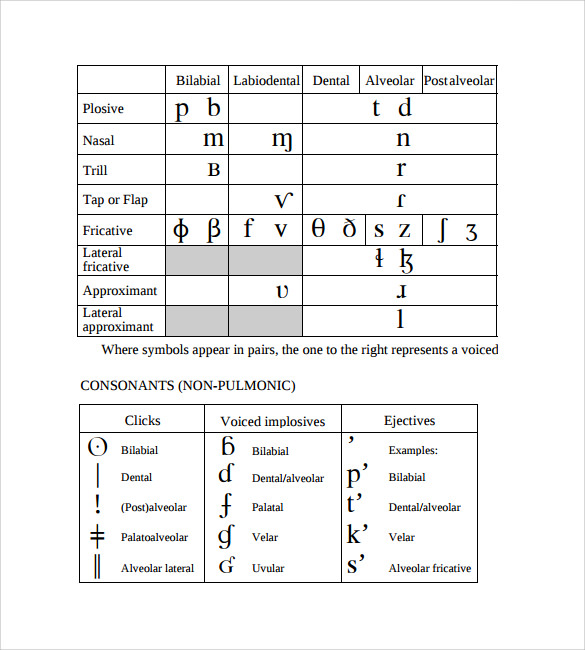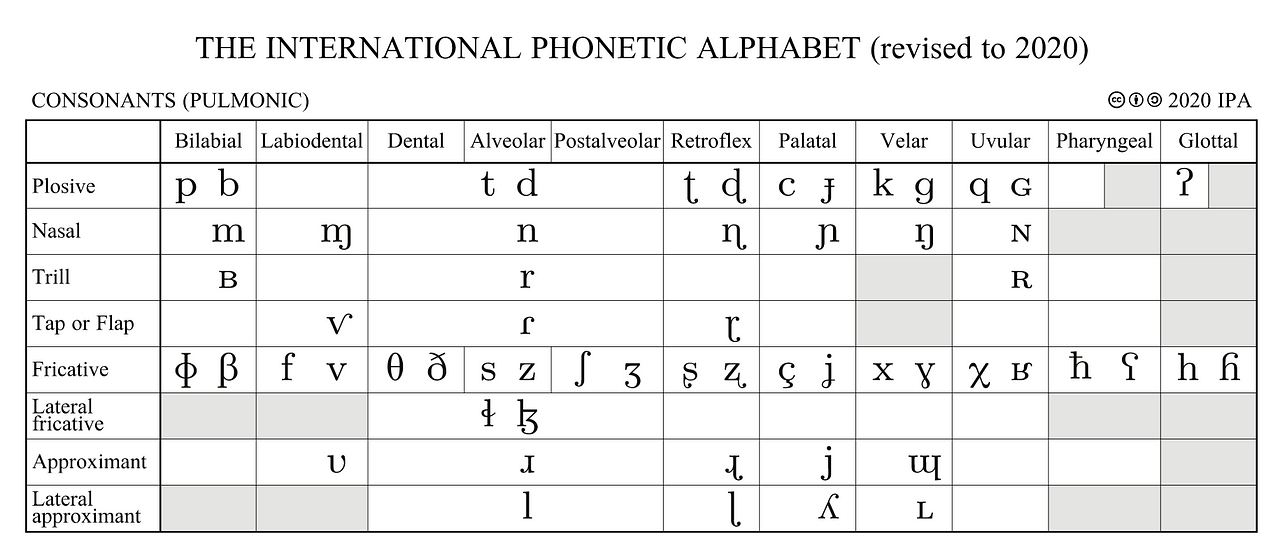International Phonetic Alphabet Uses
The International Phonetic Alphabet (IPA) is a system of phonetic notation that is widely used in linguistics, language learning, and speech pathology. It provides a standardized way to represent the sounds of human speech, regardless of the language being spoken. By using the IPA, linguists can accurately transcribe and analyze the pronunciation of words and sounds, making it an indispensable tool in the field of phonetics.
The Importance of the IPA
The IPA addresses several pain points encountered in the study of languages and speech. One of the biggest challenges is the inconsistency in spelling and pronunciation across different languages. The IPA eliminates this ambiguity by assigning specific symbols to each distinct sound, allowing for precise and consistent phonetic representation. Additionally, the IPA helps overcome language barriers by providing a universal system that facilitates the accurate pronunciation of words in any language.
The Target of the IPA
The primary target of the IPA is to provide a standardized way to represent all the sounds present in human languages. By doing so, it enables linguists, language learners, and speech professionals to accurately study and describe the phonetics of any language. The IPA serves as a reference guide, allowing individuals to compare and analyze various phonetic features, such as vowel and consonant sounds, intonation patterns, and stress accents.
Article Summary
The International Phonetic Alphabet (IPA) is a vital tool in linguistics and language-related disciplines. It provides a standardized way to transcribe and analyze speech sounds, regardless of the language. The IPA helps overcome challenges related to inconsistent spelling and pronunciation, facilitates accurate pronunciation across languages, and enables in-depth study of phonetics.
International Phonetic Alphabet Uses in Linguistics
In the field of linguistics, the International Phonetic Alphabet (IPA) is a fundamental tool. It allows linguists to accurately represent and compare the sounds of different languages. By utilizing the IPA, researchers can decipher the phonetic patterns and peculiarities specific to each language. Personally, as a linguistics student, learning the IPA has been indispensable for me. It has helped me understand the intricacies of phonetic systems and improve my ability to transcribe and analyze speech. One particularly interesting aspect of the IPA is its inclusion of diacritics and suprasegmental symbols, which provide valuable insights into intonation, stress, and other prosodic elements of speech.

International Phonetic Alphabet Uses in Language Learning
The application of the International Phonetic Alphabet (IPA) in language learning is transformative. It equips learners with a systematic approach to pronouncing words accurately, regardless of their native language. Personally, when I started learning French, the IPA helped me overcome the challenges of unfamiliar phonetic patterns. By referring to the IPA symbols and their corresponding sounds, I enhanced my pronunciation skills and gained confidence in speaking the language. The IPA is also invaluable for language teachers, as it allows them to provide precise phonetic guidance to their students. It enables learners to grasp the subtle nuances of pronunciation that often exist between languages.

Tips for Using the International Phonetic Alphabet
Here are some practical tips for effectively utilizing the International Phonetic Alphabet (IPA) in your language studies:
- Refer to reliable IPA charts and guides for accurate pronunciation references.
- Practice transcribing words and sentences using the IPA symbols to reinforce your understanding.
- Listen to native speakers and compare their pronunciation with the corresponding IPA representation to identify any discrepancies.

About the International Phonetic Alphabet
The International Phonetic Alphabet (IPA) is a powerful tool for linguistics, language learning, and speech pathology. It allows for accurate phonetic representation and analysis, enabling researchers and learners to study and understand the sounds of human speech. The IPA provides consistency in pronunciation across languages and contributes to effective language teaching and learning. Learning and utilizing the IPA can greatly enhance one’s linguistic abilities and improve communication skills.
Featured International Phonetic Alphabet Uses
The International Phonetic Alphabet (IPA) finds applications in various fields:
- Linguistics research and phonetic analysis
- Language teaching and learning
- Speech pathology and therapy
- Articulation training

Share a Personal Opinion on the Benefits of the International Phonetic Alphabet
Personally, I believe that the International Phonetic Alphabet (IPA) is an invaluable tool for anyone interested in studying languages or speech. It simplifies the learning process by providing a clear and standardized way to represent speech sounds. The IPA enables accurate pronunciation, aids in overcoming language barriers, and deepens our understanding of the phonetic intricacies of different languages. It has been instrumental in my language learning journey, allowing me to improve my pronunciation and communicate more effectively with native speakers.
Comparison of International Phonetic Alphabet Uses
When comparing the uses of the International Phonetic Alphabet (IPA) in linguistics and language learning, it becomes evident that both fields benefit greatly from its application. Linguistics relies on the IPA for accurate phonetic representation and analysis, while language learning benefits from the IPA by providing learners with a systematic approach to pronunciation. The IPA serves as a bridge between different languages, helping individuals navigate pronunciation complexities and improve their overall linguistic competence.
Fact: International Phonetic Alphabet Uses
The International Phonetic Alphabet (IPA) is a universal system used to represent the sounds of human speech. It provides a consistent and standardized way to transcribe and analyze languages worldwide. By utilizing the IPA, linguistics researchers and language learners can accurately study and understand the intricate details of pronunciation across different languages. The IPA is an essential tool for anyone interested in phonetics or language-related fields, allowing for precise representation and analysis of speech sounds.
Question and Answer about International Phonetic Alphabet Uses
Q: How does the International Phonetic Alphabet aid in language learning?
A: The International Phonetic Alphabet (IPA) serves as a guide for accurate pronunciation in language learning. It enables learners to distinguish and reproduce the specific sounds of a language, promoting clearer communication and accent reduction.
Q: How can the IPA be utilized in linguistic research?
A: In linguistics, the International Phonetic Alphabet (IPA) is indispensable for phonetic analysis and comparison. By transcribing speech using IPA symbols, researchers can study phonetic patterns, analyze phonological systems, and identify language-specific phonetic features.
Q: What role does the IPA play in speech pathology?
A: Speech pathologists use the International Phonetic Alphabet (IPA) as a diagnostic and therapeutic tool. It allows them to assess and treat articulation disorders, phonological impairments, and accent modification by accurately transcribing and analyzing speech sounds.
Q: How can the IPA help with language teaching?
A: The International Phonetic Alphabet (IPA) assists language teachers in delivering accurate pronunciation guidance to students. By using IPA symbols, teachers can demonstrate proper pronunciation, highlight phonetic differences, and improve learners’ overall oral proficiency.
Conclusion of International Phonetic Alphabet Uses
The International Phonetic Alphabet (IPA) is an essential tool for linguistics, language learning, and speech-related fields. It provides a standardized and universal way to represent and analyze the sounds of human speech, enabling precise pronunciation and facilitating cross-linguistic communication. Whether you are a language learner, linguistics student, or speech professional, the IPA offers immense benefits in understanding and mastering the phonetic intricacies of languages.
If you are looking for International Phonetic Alphabet Definition Uses Chart Britannica 49152 you’ve came to the right web. We have 10 Pictures about International Phonetic Alphabet Definition Uses Chart Britannica 49152 like International Phonetic Alphabet Use Beyond Two-Way Radios | Phonetic, International Phonetic Alphabet Definition Uses Chart Britannica 49152 and also A guide to the International Phonetic Alphabet, part I | by Brian Smith. Here you go:
International Phonetic Alphabet Definition Uses Chart Britannica 49152
www.hotzxgirl.com
International Phonetic Alphabet
dictioninfo.blogspot.com
Study Phonetics: Top Reasons Why We Should All Study Phonetics
www.rosettatranslation.com
ipa chart alphabet phonetic phonetics greek international symbols charts phonetique pronunciation unige ch list pdf tips 2005 fight sampa transcription
Sample International Phonetic Alphabet Chart – 7+ Free Documents
www.sampletemplates.com
alphabet phonetic international chart pdf
Introduction To The International Phonetic Alphabet – YouTube
www.youtube.com
alphabet phonetic international
The International Phonetic Alphabet (revised To 2015).pdf Ipa Phonetics
www.pinterest.com
alphabet phonetic international ipa pdf chart revised arabic alfabeto english fonetica internacional fonetico fonético phonetics symbols la wikipedia transcripcion sounds
International Phonetic Alphabet And Phonemic Alphabets
teachtranslatetravelrepeat.com
phonetic phonemic alphabets
International Phonetic Alphabet Use Beyond Two-Way Radios | Phonetic
www.pinterest.fr
phonetic chicomm ipa radios beyond dialects macgillivray
A Guide To The International Phonetic Alphabet, Part I | By Brian Smith
medium.com
phonetic transcription symbol
English Language – Vocabulary | Britannica
www.britannica.com
Alphabet phonetic international chart pdf. English language. A guide to the international phonetic alphabet, part i



